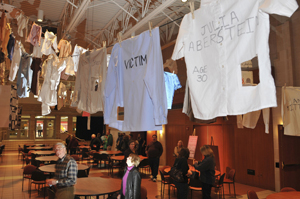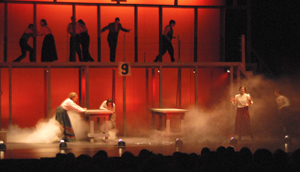
My name is Anna Cohen. I’m 25 years old. On March 11, 1911, I was working at the Triangle Shirtwaist Factory in New York City when someone threw a cigarette on a pile of fabric scraps, starting a fire that killed 146 workers, mostly women. I was one of them.…
The horrific fire and subsequent trial, which lit a torch to the smoldering issue of workers’ rights, especially those of women, were dramatized in “The Triangle Factory Fire Project” by Divine Savior Holy Angels High School students March 11-14.
The play, by Christopher Piehler and Scott Alan Evans, sets the stage for the inferno through a series of headlines shouted by “paperboys” that spell out the growing unrest among female workers and their attempts to obtain better working conditions through strikes. But many women feared that complaining about low wages, dangerous and unsanitary working conditions and long hours could cost them their jobs. So they remained silent … until the cries of those trapped in the burning clothing factory resonated through headlines across the country.
The 25-minute fire and the frantic attempts to escape the top three stories of the Asch Building were re-enacted in the midst of onstage “smoke.” Futile attempts to escape through a locked exit were recalled. A newspaper reporter on the ground described the horrifying “thud” as those who jumped to escape the flames hit the pavement, some 10 stories below.
The second act of “The Triangle Factory Fire Project” dealt with the trial of the factory owners who were charged with negligence. The pair was acquitted by a jury of 12 men.

The play was not meant to merely dramatize a disaster. Instead, it was the centerpiece of a semester-long project that involved many classes and was meant to focus on women’s issues that still prevail.
To make the drama personal, each senior, as well as each cast member, made a shirt to commemorate someone trapped in the fire. On the front were the person’s name and age. On the back were the words “victim” or “survivor.” Hundreds of the shirts hung throughout The Quad, the school’s commons area.
Before entering the theater, playgoers were handed a white swatch with the name “Anna Cohen.” At intermission, audience members gathered in The Quad with similar patches in hand, looking up at the wash lines of shirts. Almost like the people who had come to Charities Pier following the 1911 fire to see if a loved one lay among the bodies, the theatergoers quietly and reverently milled about The Quad hoping to see the words “survivor” on the shirt that matched our swatch.
The play’s director Michael Stoddard, director of theater and theater manager at DSHA, said the drama “was a true collaboration among the theology department, visual arts, behavioral science and U.S. history.” Besides the hanging shirts, The Quad had a number visual displays that used student skills learned in Adobe Photoshop class to create photos and other graphics telling of the fire, the trial, social issues of the day and media coverage.
“My hope is that the play brought light to the struggle that existed and showed the strength these women had to make change,” said Stoddard. “The project in The Quad not only demonstrated this struggle in our history but also brought light to where this struggle still exists today.”
Stoddard said high school students are “capable of internalizing these heavy topics and are capable of giving such meaty plays a strong voice. I am honored to teach and direct at DSHA where the maturity and honesty of my cast allows me to choose such difficult material.”
Also among the 250 students involved in the project were two members of the orchestra, Erin Evans and Anna Johnson, who were accompanied on piano by the school’s music director, Sam Grabow, who wrote a stirring and haunting original score for the play.
“My influence came from other composers of the time – Copland, Stravinsky, Shostakovich,” Grabow noted.
Grabow said he was immediately drawn to the project and read the script about 20 times before he came up with what he called a “minimalist” score.
“The play is so stirring, especially the fire scene. I felt my heart pumping during those scenes,” said Grabow. “It was just a fantastic experience, a wonderful show.”
Grabow, too, was impressed with the play’s message of social justice.
“Talking about social rights is relevant in any time. There are still women around the world fighting for rights. There will always be inequities,” said Grabow.
Stoddard said he believed the cries of mistreated workers can be heard today.
“When we forget, as a society, about these horrific tragedies in our history, then we let these poor victims die in vain. To remember is to honor their struggle, a struggle still being fought today. We can all learn from our past to help shape our future,” he said.
